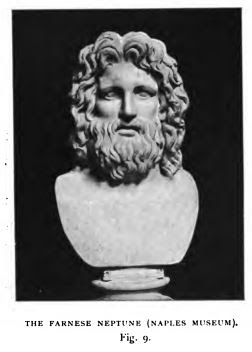Friday, 9 October 2015
The Shroud Of Christ By Paul Vignon D.Sc (Fr) Part 24.
We need not refer to the Bacchus in the National collection at Naples, but in the same collection we find a fine head (fig. 9), the Farnese Neptune, which would equally well represent Jupiter. This bust lives ; the mouth—the whole impression—commands. It is indeed one of the immortals, but it possesses none of the Divine pity of the Christ ; it wots not, cares not for the sufferings of humanity. Note how in this bust the workmanship is clear, distinct, and powerful; every chisel-mark tells.
If not among the gods of antiquity, is it among the thinkers of antiquity that we shall recognize the type of the Christ ?
We do not think that the beautiful bronze head at Naples is a Plato; it might as well be a bearded Bacchus. But there are some busts which may be actual portraits—the Sophocles in the Musee de Lateran at Rome, the Demosthenes of the Vatican, the Aeschinus of Naples.
The bust of Sophocles—admitting, that is to say, that it is Sophocles— shows us a handsome man, sure of himself, and conscious of his powers. He folds himself majestically in his toga.
Both the Demosthenes and the Aeschinus are admirable as works of art; both are instinct with the knowledge of life, both bear the marks of profound meditation. The Aeschinus is distinctly antique in type ; the head of Demosthenes (fig. 11) is, in comparison, modern. They are both sad faces, softened by the experience of suffering, gazing as it were at human misery, wishful to help, to console, men perhaps of the noblest type, but after all mere men ; and it is from no mortal head that we can seek the type of the Saviour of mankind. The head upon the Holy Shroud, though dead, seems still to be gazing higher, and still higher, through the closed, still eyelids.
It is known that the early Christians, in the mural and sepulchral pictures of the Catacombs, made no effort to portray the Saviour. The figure of the Good Shepherd, which is found there, young and beardless, bearing on his shoulders the lost sheep, is not a portrait but a symbol. Indeed, among all the discoveries of mural decoration, or sepulchral ornament found in the Catacombs there is nothing of any real artistic merit. The first and earliest representations of Christ are of an Oriental character. Nowhere in classic art is to be found any trace of the Byzantine type of Christ. To find this type of countenance which for so many centuries prevailed in art, we must leave Rome demosthenes (Vatican museum). and Athens and seek for the Semitic prototype in Syria. The examination of this later Greek art is the more interesting as the lineaments of the body impressed on the Holy Shroud are undoubtedly those of a man of Oriental race. The Byzantine Christs have a certain air of resemblance, but have nevertheless essential individual differences.



